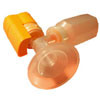- What is lactational amenorrhoea?
- The contraceptive effect of breastfeeding
- Who can use the lactational amenorrhoea method?
- Who should not use the lactational amenorrhoea method?
- Correct use of lactational amenorrhoea
- Effectiveness of lactational amenorrhoea
- Benefits of lactational amenorrhoea
- Limitations of and health risks associated with lactational amenorrhoea
- Key points to remember
What is lactational amenorrhoea?

Whilst breastfeeding, the amount of oestrogen produced by a woman’s body is reduced. Ovulation (the release of an egg from the ovaries into the fallopian tubes) only occurs when a woman produces high levels of oestrogen, because high levels of oestrogen trigger ovulation. Because a breastfeeding woman produces less oestrogen than normally, she does not ovulate and cannot become pregnant.
If a woman breastfeeds exclusively and does not give her baby any supplementary foods in the first six months after childbirth, the lactational amenorrhoea method is highly effective (98%) as long as the woman’s menstrual cycle has not returned. The method requires no special devices or procedures, and is easy to use. However, it can only be used effectively in the first six months after childbirth.
The contraceptive effect of breastfeeding
Lactation (the production of breast milk) is controlled primarily by two hormones, prolactin and oxytocin. Prolactin stimulates milk production, while oxytocin is responsible for transporting milk into the ducts which connect to the nipple.
Prolactin increases throughout pregnancy, causing the breasts to enlarge. While a woman remains pregnant she does not produce milk. This is because levels of another hormone, progesterone, also rise during pregnancy. Progesterone is produced by the placenta and so during pregnancy while the placenta remains in the woman’s womb, breast milk is not produced. Following childbirth, when the placenta is expelled, progesterone levels decrease and milk production is stimulated. The infant’s suckling at the mother’s nipple also stimulates the production of breast milk.
The infant’s suckling continues to regulate the amount of milk produced because the suckling action stimulates production of prolactin, which in turn stimulates milk production. The amount of milk produced by a lactating woman is equal to the amount consumed by the infant. When an infant stops suckling, breast milk production will quickly cease. When an infant is suckling frequently and heavily, prolactin levels will increase so that more milk can be produced.
More information on breastfeeding
The contraceptive effect of the lactational amenorrhoea method is a result of increased levels of prolactin. When prolactin levels increase, the production and secretion of another hormone, gonadotrophin releasing hormone are inhibited. When gonadotrophin releasing hormone levels reduce, the woman’s body also reduces the amount of oestrogen it produces. Ovulation cannot occur without a surge in oestrogen levels, and if a woman does not ovulate, pregnancy is prevented.
Who can use the lactational amenorrhoea method?

- They have given birth in the previous six months;
- They are breastfeeding their infant exclusively or almost exclusively; and
- They have not experienced menstrual bleeding since childbirth.
Who should not use the lactational amenorrhoea method?
The method is contraindicated in women who do not meet all of the above criteria. While non-exclusive breastfeeding can exert some contraceptive effect, the risk of pregnancy is increased.
The risk of pregnancy is also increased for women who breastfeed exclusively but express milk, either by hand or pump. Women who express milk (e.g. while they are at work) should use an additional contraceptive methods and there are numerous other methods which are safe for use during breastfeeding.
 |
For more information, see Expressing Breastmilk. |
Lactational amenorrhoea is also unsuitable for women using some medications, including mood altering medications. Women using medications should check with their doctor about whether the medications will interfere with effective use of lactational amenorrhoea.
Correct use of lactational amenorrhoea
The effectiveness of lactational amenorrhoea is highly dependent on correct use. In particular, it is important that breastfeeding must:
- Occur at regular intervals (i.e. on demand and at least every four hours during the day and every six hours at night); and
- Be exclusive, or almost exclusive (i.e. supplemental foods should not exceed 5-10% of the infant’s nutritional intake).
It is also important to begin taking another contraceptive method after six months or earlier if the menstrual cycle returns before six months after childbirth. Individuals using lactational amenorrhoea should inquire about and obtain an additional method when they are visiting a health facility, so that they are ready to commence that method at the return of menstrual bleeding. Alternatively breastfeeding women can commence using progesterone-only hormonal contraceptive methods before the return of the menstrual cycle.
Effectiveness of lactational amenorrhoea
When used by women who meet all three criteria for the method (i.e. no menstrual bleeding, exclusive breastfeeding and less than six months since childbirth) lactational amenorrhoea is effective in preventing pregnancy in 98% of cases.
Menstruation is the key factor which signals the return of fertility, and women who have returned to menses (defined as two consecutive days of bleeding or spotting) cannot use lactational amenorrhoea.
In women who do not experience menstrual bleeding and continue to breastfeed exclusively, lactational amenorrhoea provides contraceptive protection which is 94% effective, one year postpartum.
However, the effectiveness of the method is dependent of the frequency and intensity of breastfeeding. Fertility will increase as the frequency of breastfeeding and the quantity of breast milk decrease.
Women who express milk from their breasts also have a higher risk of pregnancy, even if their infant is feeding exclusively on breast milk. The limited available research suggests that effectiveness is around 95% in women who express milk.
Benefits of lactational amenorrhoea

- Decreased bleeding after childbirth (mother);
- The uterus returns to its normal size more quickly after childbirth (mother);
- Improved nutrition (infant);
- Reduced risk of infectious disease (infant).
There are also many health benefits associated with the increased birth intervals which arise from use of contraceptives.
Other benefits of lactational amenorrhoea include:
- It does not cost anything;
- No special supplies are needed; and
- It has no side effects.
Limitations of and health risks associated with lactational amenorrhoea
There are no health risks associated with the use of lactational amenorrhoea.
The use of lactational amenorrhoea is highly limited, as it is effective only in the first six months postpartum, for women that are not having menstrual periods and breastfeeding exclusively.
In Australia only 54% of women breastfeed their babies exclusively in the first three months of life and an even lower proportion (32%) manage to breastfeed exclusively for the following three months. This means that using lactational ammenorrhoea is not an option for the majority of women in Australia, and is of limited duration for those who can use it.
Lactational amenorrhoea provides no protection against sexually transmitted infections (STIs). Patients who have sexual partners of unknown STI status should be advised to use condoms to prevent STI transmission.
Key points to remember
Lactational amenorrhoea is a highly effective contraceptive method for some women, however it is only suitable for women who:
- Breast feed exclusively;
- Do not experience menstrual periods; and
- Have had a child in the previous six months
More information
 |
For more information on different types of contraception, male and female anatomy and related health issues, see Contraception. |
References
- King, J. Contraception and Lactation. J Midwifery Women’s Health. 2007;52(6):614-20
- World Health Organisation. Family Planning: A global handbook for providers. 2007. [cited 2009, June 20] Available from: www.who.int/entity/reproductivehealth/publications/family_planning/en/
- World Health Organisation Department of Reproductive Health and Research. Progesterone-only contraceptive use during lactation and its effects on the neonate. 2009 [cited 2009, June 20], Available from: http://www.who.int/reproductivehealth/publications/family_planning/en/
- Labbock, M.H. Hight-Laukaran, V. Peterson, A.E. et al. A multicenter study of the lactational amenerrhea method (LAM): I Efficacy, duration and implications for clinical application. Contraception. 1997;5:327-36
- World Health Organisation. Health benefits of family planning. 1995 [cited 2009, June 24]. Available from: http://www.who.int/reproductivehealth/publications/family_planning/HRP_FHE_FPP_95_15/en/index.html
- Family Health International. Lactational Amenorrhoea. 2009. [cited 2009, July 1] Available from: http://www.fhi.org/en/rh/faqs/lam_faq.htm
- Australian Bureau of Statistics. 4810.0.55.001- Breastfeeding in Australia 2001. Issued 17/9/2003. [cited 2009, July 29]. Available from: http://www.abs.gov.au/ausstats/abs@.nsf/mf/4810.0.55.001
All content and media on the HealthEngine Blog is created and published online for informational purposes only. It is not intended to be a substitute for professional medical advice and should not be relied on as health or personal advice. Always seek the guidance of your doctor or other qualified health professional with any questions you may have regarding your health or a medical condition. Never disregard the advice of a medical professional, or delay in seeking it because of something you have read on this Website. If you think you may have a medical emergency, call your doctor, go to the nearest hospital emergency department, or call the emergency services immediately.







